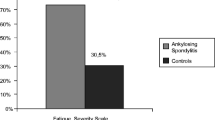Abstract
With the aim of assessing whether the Bath Ankylosing Spondylitis Activity and Function Indices (BASDAI and BASFI) are reliable measures of disease activity and function in patients with spondyloarthritides (SpAs), 341 patients with SpA (representing ankylosing spondylitis (14.5%), psoriatic arthritis (27.3%), enteropathic arthritis (6.3%), reactive arthritis (4.9%), and undifferentiated arthritis (46.5%) were asked to complete the BASDAI and BASFI. They were asked to report what their main problems associated with the disease were from a list of seven symptoms: fatigue, neck pain, upper back pain, lower back pain, stiffness, joint pain or swelling, and pain with pressure on joints. Correlations between the main symptoms experienced by patients with SpAs and the indices, defined by Spearman’s correlation coefficient, showed that BASDAI best correlated with neck pain [BASDAI 2 and total BASDAI score correlate strongly (p = 0.003 and 0.001, respectively), and BASDAI 1, 4, and 5 correlate moderately (p = 0.03, 0.02, and 0.01, respectively)], followed by stiffness, upper back pain, pain with pressure, lower back pain, fatigue, and joint pain. Stiffness correlated strongly with nine of ten items on BASFI (BASFI 1 showed moderate correlation, p = 0.01), followed by upper back pain (four of ten items correlated strongly, three of ten correlated moderately), neck pain (three of ten tasks correlated strongly and four of ten correlated moderately), lower back pain (one task correlated strongly, five moderately), joint pain and swelling (four tasks correlated moderately), fatigue (three tasks correlated moderately), and pain with pressure (two tasks correlated moderately). BASDAI and BASFI only partly reflect disease activity and patients’ functional capacity in SpAs. An alternate instrument is required to assess SpA disease activity and functional capacity more precisely.
Similar content being viewed by others
References
Dougados M, van der Linden S, Juhlin R et al (1991) The European Study Group preliminary criteria for the classification of spondyloarthropathy. Arthritis Rheum 34:1218–1227
Brandt J, Khariouzov A, Listing J et al (2004) Successful short term treatment of patients with severe undifferentiated spondyloarthritis with the anti tumor necrosis factor-alpha fusion receptor protein etanercept. J Rheumatol 31:531–538
Huerta-Sil G, Casasola-Vargas JC, Londono JD et al (2006) Low grade radiographic sacroiliitis as prognostic factor in patients with undifferentiated spondyloarthritis fulfilling diagnostic criteria for ankylosing spondylitis throughout follow up. Ann Rheum Dis 65:642–646
Collantes C, Zarco P, Munoz E et al (2006) Disease pattern of SpAs in Spain: description of the first national registry (REGISPONSER). J Rheumatol 33:2538–2540
Garrett S, Jenkinson T, Kennedy LG et al (1994) A new approach to defining disease status in ankylosing spondylitis: the Bath Ankylosing Spondylitis Disease Activity Index. J Rheumatol 21:2286–2291
Calin A, Garrette S, Whitelock H et al (1994) A new approach to defining functional ability in ankylosing spondylitis. The Bath Ankylosing Spondylitis Functional Index. J Rheumatol 21:2281–2285
Spoorenberg A, van Tubergen A, Landewe R et al (2005) Measuring disease activity in ankylosing spondylitis: patient and physician have different perspectives. Rheumatology 44:789–795
Taylor WJ, Harrison AA (2004) Could the Bath Ankylosing Spondylitis Disease Activity Index (BASDAI) be a valid measure of disease activity in patients with psoriatic arthritis? Arthritis Rheum 51:311–315
Maksymowych WP, Miller C, Velez M, Savage L (2007) To what degree do BASDAI and BASFI questionnaires address the most essential symptoms and disabilities of patients with ankylosing spondylitis? Ann Rheum Dis 66(suppl 2):405, abstract
Van der Heijde D, Lie E, Kvien TK, Sieper J, den Bosch Van, Listing J, Brown J, Landewe R, for the assessment of spondyloarthritis international society (ASAS) (2009) ASDAS, a highly discriminatory ASAS-endorsed disease activity score in patients with ankylosing spondylitis. Ann Rheum Dis 68:1811–1818. doi:10.1136/ard2008.100826
Disclosures
None.
Author information
Authors and Affiliations
Corresponding author
Rights and permissions
About this article
Cite this article
Roussou, E., Sultana, S. The Bath Ankylosing Spondylitis Activity and Function Indices (BASDAI and BASFI) and their correlation with main symptoms experienced by patients with spondyloarthritis. Clin Rheumatol 29, 869–874 (2010). https://doi.org/10.1007/s10067-010-1411-9
Received:
Revised:
Accepted:
Published:
Issue Date:
DOI: https://doi.org/10.1007/s10067-010-1411-9




